This cabinet card portrait was taken at the studio of F.B. Walcott in the town of Berlin, Wisconsin. The back of the card has a logo with F.B. Walcott, successors to S.M. Taylor printed under it. I’ve cropped and enlarged the logo, below, to make it legible. The green background is unusual:

(You can see the entire back here, and lettering on the front here.)
F.B. Walcott was probably Frank Benjamin Walcott (1861-1929), whose father was a founder of nearby Ripon College, which Frank attended. By the time of the 1900 Census, Frank was living with his wife and two daughters in Houston, Texas, where he was listed as a Retoucher (Photos).
S.M. Taylor was Schuyler M. Taylor (1843-1918), who was listed as a photographer in Berlin in the 1880 Census. The next time he appeared in a Census, in 1910, he owned a photography business in Yuba, California. He must have sold his Berlin studio to Frank Walcott in the 1880s.
The most surprising thing about this portrait is the fact that the woman is holding the man’s lapel. I’ve never seen that anywhere else! The two of them are also unusually close together for a formal portrait:

My guess would be that this was an engagement or wedding photograph. I wish I could tell you more about this couple, but their identity remains a mystery.

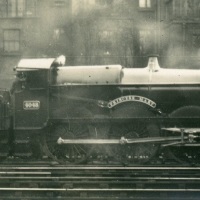
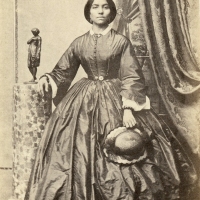
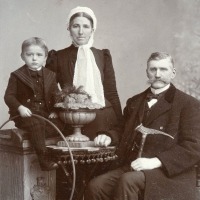
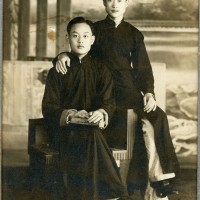
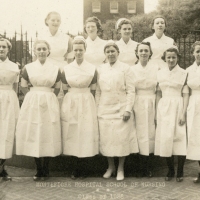
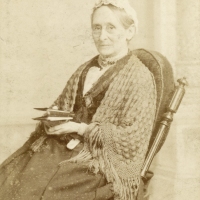
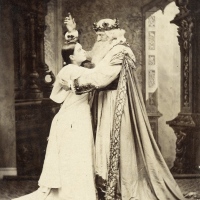
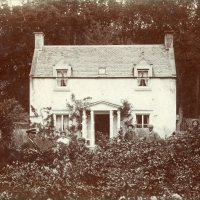
My first impression was of a brother and sister, they seem to resemble each other facially to me, but that’s just speculation.
LikeLiked by 2 people
I thought they might be brother and sister as well.
LikeLiked by 1 person
Their pose is much too intimate for them to be brother and sister. It’s downright steamy for the time, even for a couple! CJ, are you posting anywhere these days?
LikeLiked by 1 person
Yes, I post every Sunday to the 52 week photography project I’m doing. It’s in the portfolio section of my main blog so doesn’t show up in the reader but you can find it at https://fragglerocking.org/project-type/52-frames/
I also have The Other Place blog where I post movie reviews on Mondays, or snippets of life on other days, https://fragglesotherplace.com/
LikeLiked by 1 person
Great, I’ll have a look and try to keep up!
LikeLike
I’m digging his stylish hair-do.
LikeLiked by 4 people
Very stylish! I bet her hair was pretty when she let it out.
LikeLike
Your remark is right: holding someone’s lapel like that is quite unusual. 🙂
LikeLiked by 2 people
Interesting post and photo! They do stand very close. Nice to see! Maybe they were more modern than others at the time 😊
LikeLiked by 3 people
Yes, they seem uninhibited for the time. Walcott was probably about the same age as they were (he was born in 1861), so that may have helped. Nice to hear from you, Thérèse!
LikeLiked by 2 people
True – they might have felt more at ease with a photographer the same age:)
LikeLiked by 1 person
A most unusual pose; frozen in time. I wonder about the book. And his feet crossed at the ankles. That seems different from other photos. Another unsolved mystery. 🙂
LikeLiked by 3 people
I hadn’t noticed his feet. He seems pretty relaxed. I wish I could go back and be a fly on the wall in that studio! 😄
LikeLiked by 1 person
Me, too! It’s always fun to imagine a story about the people in these photos. 🙂
LikeLiked by 1 person
I wonder if she’s holding his lapel because there isn’t another comfortable position for her hand. As close as she’s standing to him, the natural place for her to rest her hand would be on his other shoulder–but that would put his cheek against her bosom.
LikeLiked by 3 people
Yes, I wondered if her grip on his lapel was to keep herself from moving. Even so, she didn’t have to stand so close to him. I also wondered if the pose was her idea or Walcott’s, or a collaboration.
LikeLike
My initial thought, before reading your text, was: newlyweds. They look so young! Plus, they’re posing close to each other, and in a relaxed, familiar fashion. So of course I looked at her left hand, searching for a ring, and…is that a ring, or even two, on her index finger? Can’t tell if there’s one on her ring finger as the photo washes out. Or, have I got right and left backwards (because this is a photo), and is that a ring on the ring finger of the hand grasping the lapel?
Her hand’s position is odd, but putting myself in her shoes I imagine how my hand would jut out in front of him if I rested my forearm on his shoulder, which would be a more natural pose given her position beside him. So maybe the best solution was to grasp his lapel so that her hand stayed back and down in a somewhat natural position, not obscuring his face? So many possible explanations, including an individual quirk of the photographer and/or the person posing!
As for the book he holds: maybe he was a teacher?
I love these mysteries you present to us!
LikeLiked by 3 people
She does appear to have a ring on the index finger of her left hand, but I don’t see a ring on her right hand. Would a ring on the index finger signify anything? Something to look into! I thought she might have gripped his lapel to keep herself steady for the camera. Your explanation also makes sense.
He could very well have been a teacher. One thing that confounded me was his frock coat. I associate them with the 1860s and 1870s, but not the 1880s. Maybe I’m wrong and they were still common, but the frock coat may have been a sort of unofficial uniform of male teachers, which went out of style earlier in the general population. Something else to look into!
I’m glad you get a kick out of these mysteries!
LikeLiked by 1 person
That really is quite the grip on the lapel! It doesn’t seem relaxed, but forceful – very possessive. “Ha ha, ladies! He’s mine, all mine!!” Newlyweds, I think.
LikeLiked by 2 people
Her dress is fancy enough to be a wedding dress, and his outfit is also very formal. Almost certainly newlyweds! That might explain the possessiveness. 😉
LikeLiked by 1 person
A mischief and mystery about the photograph! The first thing that came to my notice is, they both are looking at different directions!
And am fascinated by that emerald green and the logo of the cherubim holding the old time camera.
Very interesting!
LikeLiked by 3 people
I like the green back, too, but it makes the logo very hard to read. That may be why it wasn’t used very often. Most backs were light colors or, less often, very dark colors. This green is kind of in-between. It’s a pretty color, though. Thank you, Rethy! 🙂
LikeLiked by 1 person
Yes, I was curious about the different directions they were looking. It looks intentional too, because it seems they are gazing in opposite directions by about the same degree or angle. Perhaps the assistants set it up that way.
LikeLiked by 1 person
I suspect you’re right, Alisen. My understanding is that poses were usually suggested by photographers.
LikeLiked by 1 person
At least there is more detail about this one! I like the woman’s dress. It makes me think of a mermaid.
LikeLiked by 2 people
Oh, I like that! A mermaid dress! 🙂
LikeLike
Certain things are to be left unidentified, so it mystifies people of all times!
LikeLiked by 1 person
It’s true! Many mysteries will never be solved, but I always have hope. Thank you for your visit! 🙂
LikeLiked by 1 person
She appears determined; he seems resigned. I laughed at their expressions. Whatever the story is, there’s clearly a story. Like you, I’d love to have been around at the time to learn what it was.
LikeLiked by 2 people
His expression does seem rather blasé. If we could hear them talk, I wonder what kind of accents they’d have. Assuming they weren’t immigrants, would they sound like modern-day Midwesterners? Would they use slang that we wouldn’t understand? (Probably.) It’s fun to think about such things.
LikeLiked by 1 person
I love, LOVE her dress. It’s so beautiful.
Very unusual, her holding his lapel, as you and other readers have pointed out. It’s almost vaguely threatening, as in, “You’d better sit still, buster, if you know what’s good for you.”
LikeLiked by 2 people
You have a dramatic take on things, haha! I agree about her dress, it seems very special. I wonder what color it was? It fits her like a glove. Thank you for stopping by and making me smile, Ruth!
LikeLiked by 1 person
Mistress photo?
LikeLiked by 1 person
I’ve never heard of anything like that. Engagement, maybe.
LikeLiked by 1 person
This photo made me search for information on the Internet. Of course, I didn’t find anything like that. Your photos, Brad, are unique.
In these old photos, the standing person always held on to the sitting person. Because it was hard to stand in one position for a long time. Maybe the man’s shoulder was tired and the woman began to hold on to the man’s clothes. She looks tired. She’s wearing a gorgeous dress. The man’s hairstyle is also very interesting!
LikeLiked by 2 people
It’s true that putting a hand on the man would help the woman remain still. You like his hair? 😀 I like his striped bow tie. 🙂
LikeLike
I can’t imagine how much work you do tracking down the census data. Is it digital now or are you pouring over hard copies (or PDF versions?)?
LikeLiked by 1 person
Most federal and state-level records are digital these days. You can often find some information if you have a name and location. County and town records are much less likely to be digitized. Serious researchers still travel to local courthouses or historical societies to find those. Family trees are often the best source of information, if you can find them on Ancestry or a public website.
LikeLike
Yup. That’s a lot of work on your part. Have people found photos of their ancestors on your web page?
LikeLiked by 1 person
That happened once! I’ve also been contacted by descendants of photographers who took photos on the blog. That’s happened twice.
LikeLike
Nice historic picture! Greetings from Berlin, Germany 😉
LikeLiked by 1 person
Thank you! I think most states in the USA have a town named Berlin. Berlin, Vermont, was founded in 1763. 🙂
LikeLiked by 1 person
Interesting! I suppose that it was founded by German (Prussian??) settlers, maybe they fled from Europe because of the Seven-Years-War…
LikeLiked by 1 person
Actually I don’t know of any German or Prussian settlers there at that time, but the town’s founders may have hoped to attract them. You were right to mention the Seven Years’ War, because the French and Indian War (1754-1763) made settlement in this area very difficult before 1763.
LikeLiked by 1 person